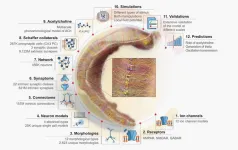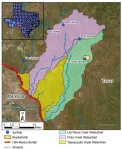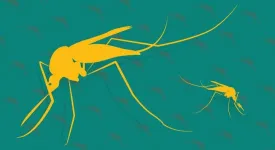(Press-News.org) At the end of the last global ice age, the deep-frozen Earth reached a built-in limit of climate change and thawed into a slushy planet.
Results from a Virginia Tech-led study provide the first direct geochemical evidence of the slushy planet — otherwise known as the “plumeworld ocean” era — when sky-high carbon dioxide levels forced the frozen Earth into a massive, rapid melting period.
“Our results have important implications for understanding how Earth's climate and ocean chemistry changed after the extreme conditions of the last global ice age,” said lead author Tian Gan, a former Virginia Tech postdoctoral researcher. Gan worked with geologist Shuhai Xiao on the study, which was released Nov. 5 in the Proceedings of the National Academy of Sciences journal.
Deep-frozen Earth
The last global ice age took place about 635 million to 650 million years ago, when scientists believe global temperatures dropped and the polar ice caps began to creep around the hemispheres. The growing ice reflected more sunlight away from the Earth, setting off a spiral of plunging temperatures.
“A quarter of the ocean was frozen due to extremely low carbon-dioxide levels,” said Xiao, who recently was inducted into the National Academy of Sciences.
When the surface ocean sealed, a chain of reactions stuttered to a stop:
The water cycle locked up. No evaporation and very little rain or snow.
Without water, there was a massive slowdown in a carbon-dioxide consuming process called chemical weathering, where rocks erode and disintegrate.
Without weathering and erosion, carbon dioxide began to amass in the atmosphere and trap heat.
“It was just a matter of time until the carbon-dioxide levels were high enough to break the pattern of ice,” Xiao said. “When it ended, it probably ended catastrophically.”
Plume world
Suddenly, heat started to build. The ice caps began to recede, and Earth’s climate backpedaled furiously toward the drippy and soupy. Over a mere 10 million years, average global temperatures swung from minus 50 to 120 degrees Fahrenheit (minus 45 to 48 degrees Celsius).
But the ice didn’t melt and remix with seawater at the same time. The research findings paint a very different world than what we can imagine: vast rivers of glacial water rushing like a reverse tsunami from the land into the sea, then pooling on top of extra salty, extra dense ocean water.
The researchers tested this version of the prehistoric world by looking at a set of carbonate rocks that formed as the global ice age was ending.
They analyzed a certain geochemical signature, the relative abundance of lithium isotopes, recorded within the carbonate rocks. According to plumeworld ocean theory, the geochemical signatures of freshwater would be stronger in rocks formed under nearshore meltwater than in the rocks formed offshore, beneath the deep, salty sea — and that’s exactly what the researchers observed.
The findings bring the limit of environmental change into better focus, said Xiao, but they also give researchers additional insight into the frontiers of biology and the resiliency of life under extreme conditions — hot, cold, and slushy.
Study collaborators include:
Ben Gill, Virginia Tech associate professor of sedimentary geochemistry
Morrison Nolan, former graduate student, now at Denison University
Collaborators from the Chinese Academy of Sciences, University of Maryland at College Park, University of Munich in Germany, University of North Carolina at Chapel Hill, and University of Nevada at Las Vegas END
Groundbreaking study provides new evidence of when Earth was slushy
The planet underwent a massive, rapid melting period after the last global ice age, the new study suggests.
2024-11-05
ELSE PRESS RELEASES FROM THIS DATE:
International survey of more than 1600 biomedical researchers on the perceived causes of irreproducibility of research results
2024-11-05
International survey of more than 1600 biomedical researchers on the perceived causes of irreproducibility of research results
#####
In your coverage, please use this URL to provide access to the freely available paper in PLOS Biology: http://journals.plos.org/plosbiology/article?id=10.1371/journal.pbio.3002870
Article Title: Biomedical researchers’ perspectives on the reproducibility of research
Author Countries: Canada, Australia, United States
Funding: The author(s) received no specific funding for this work. END ...
Integrating data from different experimental approaches into one model is challenging – this study presents a community-based, full-scale in silico model of the rat hippocampal CA1 region that integra
2024-11-05
Integrating data from different experimental approaches into one model is challenging – this study presents a community-based, full-scale in silico model of the rat hippocampal CA1 region that integrates diverse experimental data from synapse to network
#####
In your coverage, please use this URL to provide access to the freely available paper in PLOS Biology: http://journals.plos.org/plosbiology/article?id=10.1371/journal.pbio.3002861
Article Title: Community-based reconstruction ...
SwRI awarded grant to characterize Las Moras Springs watershed
2024-11-05
SAN ANTONIO — November 5, 2024 — Hydrologists at Southwest Research Institute (SwRI) will begin a 12-month targeted water-sampling campaign of the Las Moras Springs system near Brackettville, Texas. The project will analyze and characterize the system of springs and their relationship to the Pinto Creek watershed to improve water management and conservation efforts.
“Las Moras, like many other Texas spring systems, are at-risk and prone to going dry. It is important to clear up uncertainties about their source and relationship with ...
Water overuse in MATOPIBA could mean failure to meet up to 40% of local demand for crop irrigation
2024-11-05
Considered one of the fastest-growing agricultural frontiers in Brazil, and the area with the highest greenhouse gas emissions in the Cerrado, Brazil’s savanna-type biome, the region known as MATOPIBA risks facing water shortages in the years ahead. Water overuse may mean that between 30% and 40% of demand for crop irrigation cannot be met in the period 2025-40. MATOPIBA is a portmanteau of the names of four states – Maranhão, Tocantins, Piauí, and Bahia (all but Tocantins located in Brazil’s Northeast ...
An extra year of education does not protect against brain aging
2024-11-05
Thanks to a 'natural experiment' involving 30,000 people, researchers at Radboud university medical center were able to determine very precisely what an extra year of education does to the brain in the long term. To their surprise, they found no effect on brain structure and no protective benefit of additional education against brain aging.
It is well-known that education has many positive effects. People who spend more time in school are generally healthier, smarter, and have better jobs and higher incomes than those with less education. However, whether prolonged education actually causes changes in brain structure over the long term ...
Researchers from Uppsala and Magdeburg obtain an ERC Synergy Grant to advance cancer immunotherapy
2024-11-05
Targeting and customizing blood vessels in tumors to increase T cell infiltration and maintain their function may represent the next breakthrough in cancer therapy. The European Research Council has recognized this by awarding a prestigious Synergy Grant to the project VASC-IMMUNE, where three researchers, each possessing complementary expertise in this research topic, will synergize to advance the field. Professors Anna Dimberg and Magnus Essand are both from the Department of Immunology, Genetics and Pathology, Uppsala University and Professor Thomas Tüting is from the Department of Dermatology, University Hospital Magdeburg.
The successful implementation ...
Deaf male mosquitoes don’t mate
2024-11-05
Mosquitoes are much more blunt. Mating occurs for a few seconds in midair. And all it takes to woo a male is the sound of a female’s wingbeats. Imagine researchers’ surprise when a single change completely killed the mosquitoes’ libidos.
Now a study out of UC Santa Barbara reveals that this is really all there is to it. Researchers in Professor Craig Montell’s lab created deaf mosquitoes and found that the males had absolutely no interest in mating. “You could leave them together with the females ...
Recognizing traumatic brain injury as a chronic condition fosters better care over the survivor’s lifetime
2024-11-05
INDIANAPOLIS – A commentary, published in the Journal of Neurotrauma, calls for traumatic brain injury to be recognized as a chronic condition as are diabetes, asthma, depression and heart failure.
To provide comprehensive care for traumatic brain injury throughout individuals’ lifespans, the authors propose that coordinated care models they and others have developed, tested and applied to various populations -- including older adults, individuals living with depression and post-intensive care unit survivors -- be adapted to improve communication and integration between brain injury specialists -- including ...
SwRI’s Dr. James Walker receives Distinguished Scientist Award from Hypervelocity Impact Society
2024-11-05
SAN ANTONIO — November 5, 2024 —Southwest Research Institute’s Dr. James Walker has received the Distinguished Scientist Award from the Hypervelocity Impact Society. This honor recognizes individuals who have made a significant and lasting contribution to the field of hypervelocity science. Hypervelocity impact is typically viewed as impacts at speeds above 2 kilometers per second (4,475 miles per hour); for some materials, however, lower speed impacts display hypervelocity impact effects.
The ...
A mother’s health problems pose a risk to her children
2024-11-05
Women with polycystic ovary syndrome (PCOS) and obesity are at a higher risk of giving birth to smaller babies in terms of birth weight, length, and head circumference, according to a recent study conducted at the Norwegian University of Science and Technology (NTNU).
One in eight women is affected by the hormone disorder PCOS. Common characteristics are elevated levels of male sex hormones, infrequent or irregular menstrual periods, and the formation of small cysts on the ovaries.
In the study, 390 children born to women ...
LAST 30 PRESS RELEASES:
Tracing the quick synthesis of an industrially important catalyst
New software sheds light on cancer’s hidden genetic networks
UT Health San Antonio awarded $3 million in CPRIT grants to bolster cancer research and prevention efforts in South Texas
Third symposium spotlights global challenge of new contaminants in China’s fight against pollution
From straw to soil harmony: International team reveals how biochar supercharges carbon-smart farming
Myeloma: How AI is redrawing the map of cancer care
Manhattan E. Charurat, Ph.D., MHS invested as the Homer and Martha Gudelsky Distinguished Professor in Medicine at the University of Maryland School of Medicine
Insilico Medicine’s Pharma.AI Q4 Winter Launch Recap: Revolutionizing drug discovery with cutting-edge AI innovations, accelerating the path to pharmaceutical superintelligence
Nanoplastics have diet-dependent impacts on digestive system health
Brain neuron death occurs throughout life and increases with age, a natural human protein drug may halt neuron death in Alzheimer’s disease
SPIE and CLP announce the recipients of the 2025 Advanced Photonics Young Innovator Award
Lessons from the Caldor Fire’s Christmas Valley ‘Miracle’
Ant societies rose by trading individual protection for collective power
Research reveals how ancient viral DNA shapes early embryonic development
A molecular gatekeeper that controls protein synthesis
New ‘cloaking device’ concept to shield sensitive tech from magnetic fields
Researchers show impact of mountain building and climate change on alpine biodiversity
Study models the transition from Neanderthals to modern humans in Europe
University of Phoenix College of Doctoral Studies releases white paper on AI-driven skilling to reduce burnout and restore worker autonomy
AIs fail at the game of visual “telephone”
The levers for a sustainable food system
Potential changes in US homelessness by ending federal support for housing first programs
Vulnerability of large language models to prompt injection when providing medical advice
Researchers develop new system for high-energy-density, long-life, multi-electron transfer bromine-based flow batteries
Ending federal support for housing first programs could increase U.S. homelessness by 5% in one year, new JAMA study finds
New research uncovers molecular ‘safety switch’ shielding cancers from immune attack
Bacteria resisting viral infection can still sink carbon to ocean floor
Younger biological age may increase depression risk in older women during COVID-19
Bharat Innovates 2026 National Basecamp Showcases India’s Most Promising Deep-Tech Ventures
Here’s what determines whether your income level rises or falls
[Press-News.org] Groundbreaking study provides new evidence of when Earth was slushyThe planet underwent a massive, rapid melting period after the last global ice age, the new study suggests.






